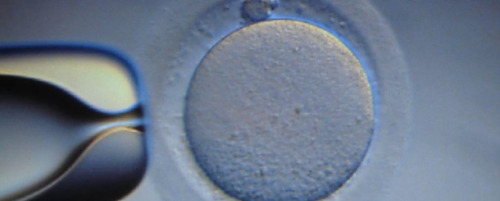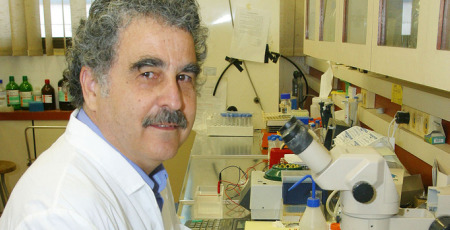By mimicking the processes in nature that contribute to sperm selection, an Israeli professor is hoping to improve both the success of IVF and the health of infants.

It’s a popular misconception, explains Israeli scientist Prof. Haim Breitbart, that the fastest sperm is the one that fertilizes the egg. The biochemist from Israel’s Bar Ilan University in Ramat Gan, is dedicated to finding ways to make in vitro fertilization (IVF) as similar as possible to the process that occurs naturally. His new research reveals much about the behavior of sperm and may pave the way to more successful pregnancies and healthier babies.
When they’re in the uterus, human sperm have to undergo a biochemical process called capacitation, Breitbart explains. Without this process, which takes about three hours, they are incapable of binding to, and thus penetrating an egg, to fertilize it.
During IVF treatments, rather than allowing sperm to undergo this process and then race to an egg on their own, doctors generally arbitrarily choose one sperm and insert it directly into an egg in a process called Intra Cytoplasmic Sperm Injection (ICSI). With this approach, there is no need for capacitation.
However, Breitbart, who specializes in male infertility and wrote a report in 2003 revealing that sperm operate like guided, heat-seeking missiles on their way to the egg, believes that this practice may generate its own particular health consequences.
The sperm race together with the biochemical changes in the sperm, are natural strategies that ensure that the fittest sperm will eventually fertilize the egg. When doctors “play God” he tells ISRAEL21c, it may result in the risk of conditions such as autism.
Helping IVF resemble nature
Breitbart was recently featured in ISRAEL21c for his work developing a male birth control pill. His goal is to develop strategies to make the IVF process resemble as closely as possible what occurs in nature. The latest research released by his lab shows that when radiation or visible light is applied to sperm, motility may be increased and the chances of conceiving through IVF are improved.
Yes, the radiation is applied to the sperm in the lab, and not directly to the scrotal sac, he laughs, telling ISRAEL21c that humor is part of his approach to solving the male infertility problem. “Otherwise we could just go to the beach and sunbathe nude,” Breitbart says.
While women often get the bad rap, infertility can just as easily be a male problem. About 35 to 40 percent of the couples who are having trouble conceiving can blame the sperm, states Breitbart.
“When a man comes to the clinic he gives sperm and tests are done if his partner can’t become pregnant. If they find sperm motility is fine, they’ll look at count. If that’s fine, they’ll look at sperm morphology. If that is fine too, they’ll go to IVF. If there is no success, there is still a 15 to 20 percent chance (when other factors are ruled out) of unexplained infertility in men,” Breitbart explains. At this stage doctors will micro-manipulate sperm – by taking a single one and injecting it into the female egg to create an embryo.

But how do doctors know which sperm to select? As a scientist he has a problem with the current haphazard selection process and is determined to bring IVF closer to what nature intends. “This is the rationale behind my work. When ICSI is performed, the physician is playing God. He thinks he knows what he is doing, but there is really no way to tell if this is the best sperm. We believe there is a selection process in nature.
Getting the fittest sperm to the egg
“What I am doing as a biologist is coming as close as I can to nature to improve sperm. There are a few biochemical parameters involved in maturation of the sperm in the female. Sperm can reach the egg within one minute, but they will not fertilize this egg,” he explains. “They should reside in the uterus for three hours and during this time of incubation in the uterus sperm undergo a few biochemical changes – only capacitated sperm can bind to the egg and fertilize it.
“We can mimic the conditions of the female in the test tube. We can take sperm and incubate it, mimicking the capacitation process,” Breitbart continues.
In some cases, the professor might also suggest irradiating the sperm, so those which have undergone capacitation in the tube can become better swimmers.
In a recent study, Breitbart and his colleagues found that after three minutes of exposure to radiation there was an increase in oxygen particles in the sperm, which led to increased motility, and upped the chances that the fittest sperm would eventually reach the egg without medical intervention.
This technique may be applied in IVF clinics in the future. Collaborators on Breitbart’s research include professors Adrian Shulman, Arieh Raziel and Rafael Ron-El; doctors Amir Weizer and Nir Etkovitz, and students Shiran Shachar and Mali Rotlevi.
Better swimmers
Breitbart’s findings encouraged him to found a start-up called Preon. “Our aim is to describe the capacitation ability of the sperm. Today all the tests in the hospitals cannot tell which sperm have this ability. Our new assay would give a very good answer to the physician by which we can explain in some cases why the fertilizing potential is so low.
“We can then suggest that the physician go straight to the ICSI method – or my biochemical test may show that the capacitation potential is high,” Breitbart relates, suggesting that radiating sperm so that they can swim better might be a more fair treatment for the sperm of infertile couples seeking to conceive through IVF.
A kit to provide such sperm data could be ready within a couple of years. The knowledge to produce it is based on years of studies in various Israeli hospitals supplying data about couples that received treatment.











